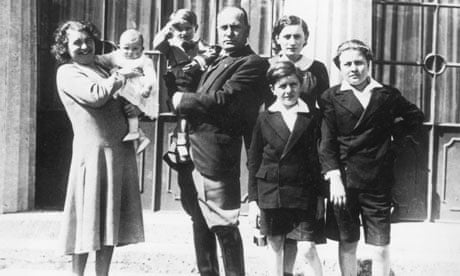In 1919 Benito Mussolini, an obscure political agitator, assembled a ragbag of black-shirted followers in Milan, and launched the political movement that was to become, two years later, the National Fascist party. The party took its name from the classical Roman symbol of authority – an axe bound in rods, or fasces. Part idealist, part buffoon, Mussolini dreamed of a second Roman empire for Italy, and dominion over the Mediterranean. Occasionally he liked to wear a richly tasselled fez and would pose for the cameras, thrusting out his chin pugnaciously. He introduced the stiff-armed Roman salute, disapproving of the handshake as fey and unhygienic. As Mussolini's regime strengthened, the high priests of fascism began to hail their leader as "divine Caesar", and adopted the passo romano, the Latin goosestep, in parades. Behind the bombast, however, Italian fascism relied on bludgeons, intimidation and, according to Roberto Olla, Mussolini's vainglorious sexual antics and boastfulness.
Olla, an Italian writer and TV journalist, provides an absorbing account of Mussolini's self-proclaimed manful potency and "animal allure". In the course of his life, he had relations with hundreds of women, perhaps "as many as 400". The women were brusquely mauled by him under his desk or on mattress-like cushions installed for the purpose. Towards the end of his 23-year-dicatorship, facing defeat, he became addicted to a German-manufactured aphrodisiac pill trade-marked Hormovin. Taking this prototype Viagra was a "political act", says Olla, as it served to prolong the myth of the Duce as one who never flagged. Undeniably, sex was at the centre of the myth of Mussolini and his image as a man of power. Yet Mussolini's sexuality has been "ignored" by historians as being unworthy of study. In Il Duce and His Women, Olla remedies the deficiency, and gives us a portrait of Mussolini in all his priapic foolery – and occasional daring.
Mussolini's most notorious mistress, Claretta Petacci, saw a "god-like potency" and "bull-like" magnetism in her idol. A doctor's daughter, she began to court Mussolini in 1932 and before long, bouts of "savage, ardent sex" routinely occurred in his headquarters at Palazzo Venezia in Rome. Mussolini was by then married with five children, yet the more women he had, the more he felt puffed out with a sense of his own rank and self-importance. Petacci's diaries, first published in Italy in 2009 as Mussolini segreto ("Secret Mussolini"), are amply quoted by Olla. In spite of her adoring pillow talk ("Anchor yourself in me, my great and glorious ship"), Petacci has much to say about Mussolini's inner life, personality and politics. He forbade his daughter from marrying a Jew, yet one of his mistresses, Margherita Sarfatti, was Jewish. Sarfatti, a rather "overlooked character", according to Olla, exerted a stronger influence on the dictator than is generally realised.
She first met Mussolini in 1912, and was one of the masterminds behind fascism's pompous celebration of ancient Rome. The eagle motifs and suckling she-wolves visible today on fascist architecture in Italy are partly Sarfatti's legacy. Her bestselling 1926 biography of Mussolini, Dux, exalted the leader as a sacred manifestation of romanità ("Romanness") and the noble Italian race. Yet her name was dirt once Mussolini had committed Italy to Nazi Germany's antisemitic cause. A racial dogma that glorified blond northerners of course conflicted somewhat with the Mediterranean cult of romanità. Yet a latent tension had always existed between fascism and Italian Jews. Zionists, in particular, were seen by Mussolini as a self-regarding, supranational sect inimical to the sturdy Blackshirt. "They should mind their own business," Mussolini told Petacci while sunbathing with her one day in Rome. "They are carogne [carrion], cowards." While Sarfatti managed to escape Nazi-occupied Italy, her sister Nella and her husband died on a transport bound for Auschwitz.
To Petacci, Hitler was unappealingly furtive and rat-like beside her grandly uniformed Dux, whose smouldering, lantern-jawed features were said to radiate a sense of physical daring – ardimento – and the very masculine fascist soul. Other women were no less impressed. Ida Dalser went so far as to sell her beauty salon in order to raise funds for Mussolini. In time, she became the mother of Mussolini's first-born son and, it seems, married the dictator. Years later, after Mussolini had cynically discarded her, Dalser accused him of cowardice and dereliction of duty. Enraged, Mussolini confined Dalser to a mental home, where, shortly before Christmas 1937, she died.
Olla's biography ends that momentous year of 1937, when Mussolini paid his disastrous official visit to Nazi Germany. Having invaded Abyssinia (now Ethiopia) two years earlier, the dictator decided to hitch his carnival chariot to Hitler's funeral hearse, and a last chance for peace in Europe was lost. Olla has read widely into the cult of ducismo, and writes illuminatingly of his subject. Ultimately, his psycho-sexual study asserts the dangers of blind adherence to ideology. In April 1945, with Italy's defeat now certain, Mussolini was executed by anti-fascists and his body strung up alongside that of the starry-eyed Claretta Petacci in Milan, not far from the site where, 26 years earlier, the fascist movement had been launched.





Comments (…)
Sign in or create your Guardian account to join the discussion